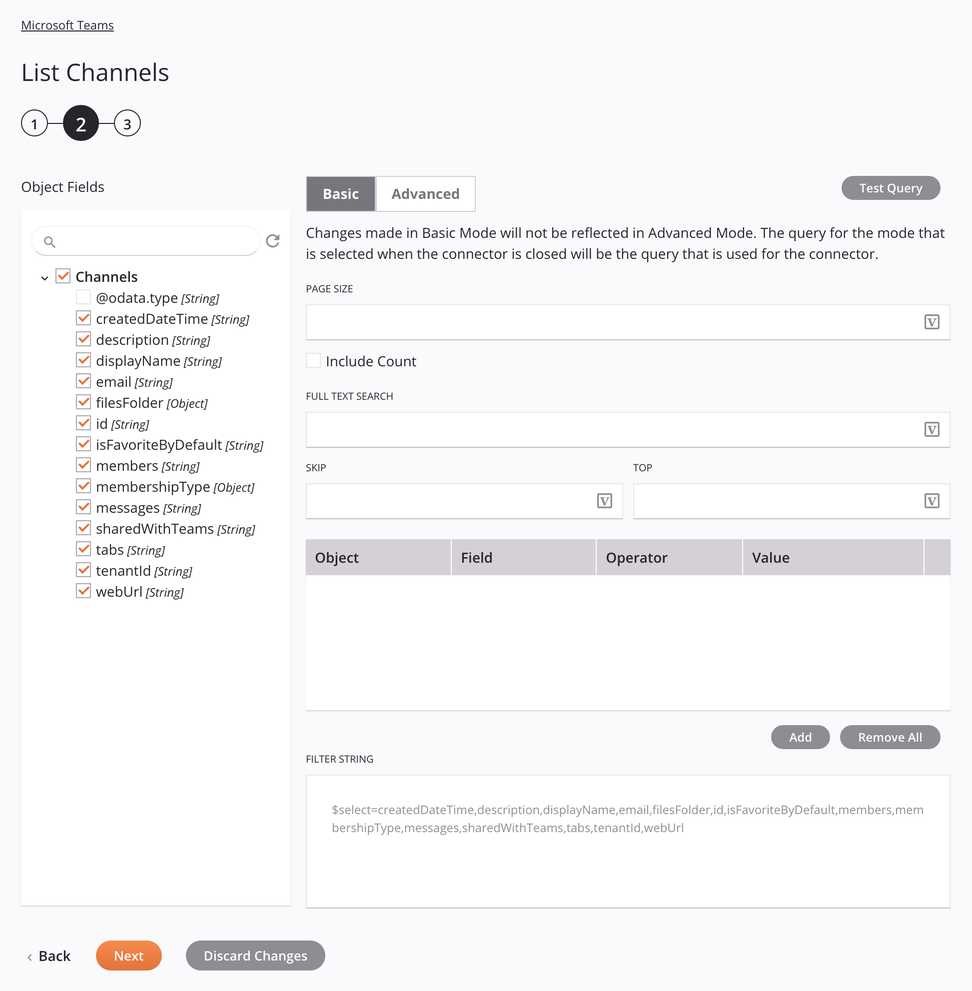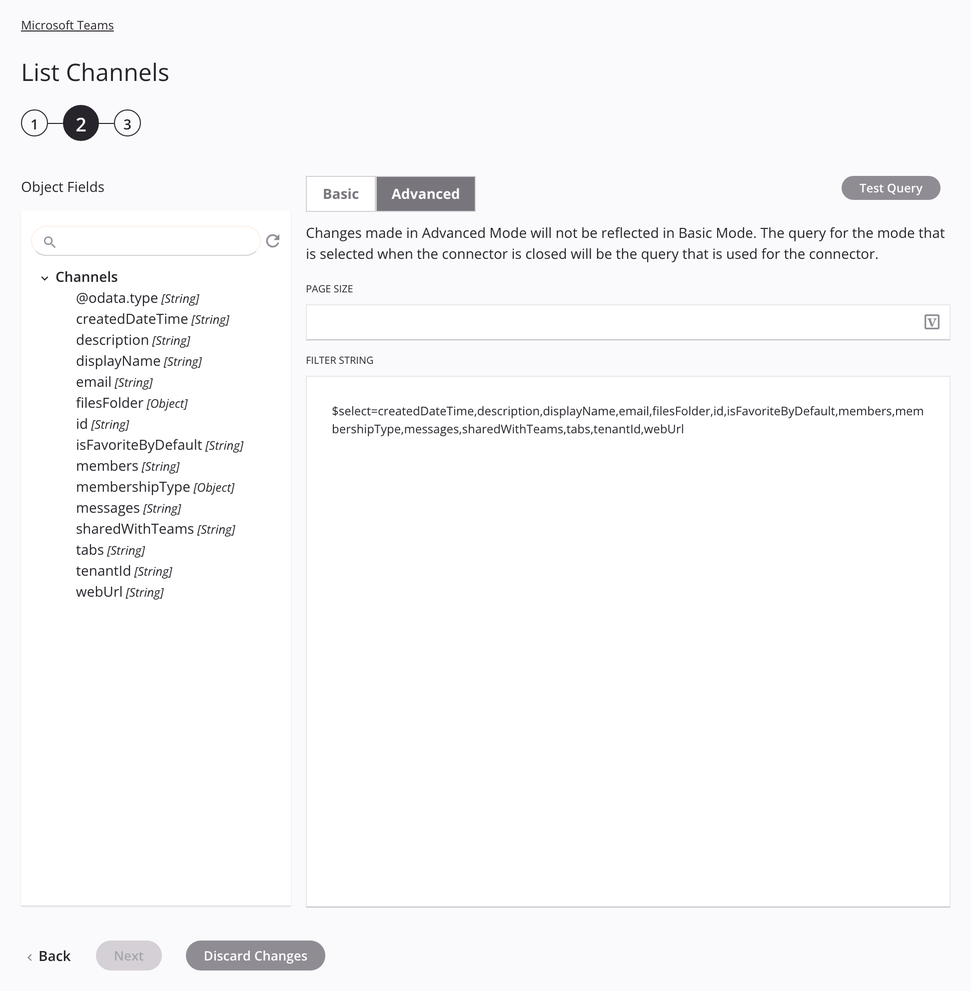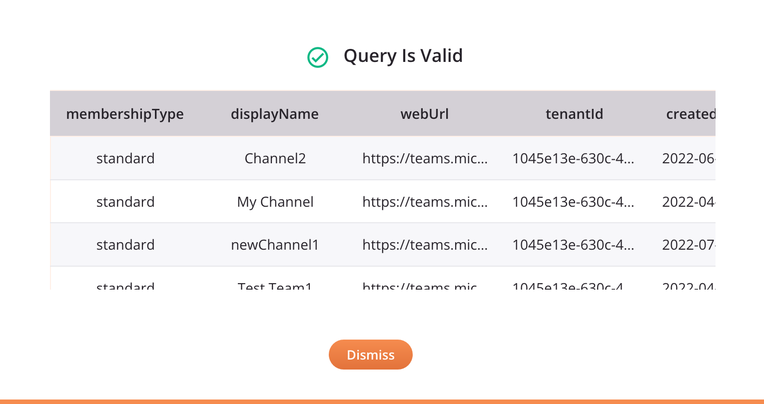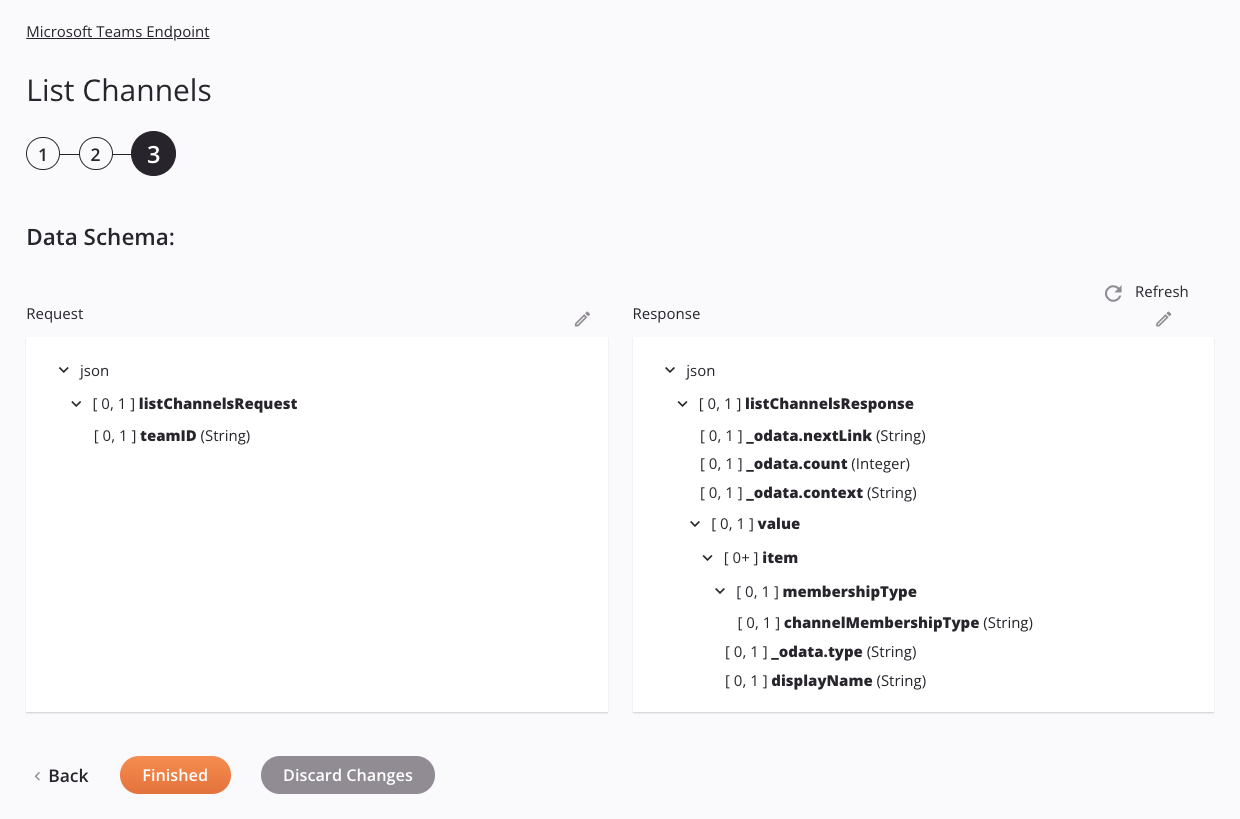Microsoft Teams List Channels activity
Introduction
A Microsoft Teams List Channels activity, using its Microsoft Teams connection, retrieves a list of channels for a team at Microsoft Teams and is intended to be used as a target to consume data in an operation.
Known issues
The Microsoft Teams connector has this known issue:
-
Testing a query in a Microsoft Teams List Channels activity fails if a team name contains spaces
-
Summary: Testing a query in step 2 of a Microsoft Teams List Channels activity fails with an Invalid Query error if the Microsoft Teams team name contains spaces.
-
Additional Information: The issue is limited to testing of the query. The activity configuration can still be completed. At runtime, the operation will return the expected channel details.
-
Create a Microsoft Teams List Channels activity
An instance of a Microsoft Teams List Channels activity is created from a Microsoft Teams connection using its List Channels activity type.
To create an instance of an activity, drag the activity type to the design canvas or copy the activity type and paste it on the design canvas. For details, see Creating an activity instance in Component reuse.
An existing Microsoft Teams List Channels activity can be edited from these locations:
- The design canvas (see Component actions menu in Design canvas).
- The project pane's Components tab (see Component actions menu in Project pane Components tab).
Configure a Microsoft Teams List Channels activity
Follow these steps to configure a Microsoft Teams List Channels activity:
-
Step 1: Enter a name and select a team
Provide a name for the activity and select a team. -
Step 2: Define a filter string
Set conditions on a query using the channel fields and apply paging to a query. -
Step 3: Review the data schemas
Any request or response schemas generated from the endpoint are displayed.
Step 1: Enter a name and select a team
In this step, provide a name for the activity and select a team. Each user interface element of this step is described below.

-
Name: Enter a name to identify the activity. The name must be unique for each Microsoft Teams List Channels activity and must not contain forward slashes
/or colons:. -
Select a Team: This section displays teams available in the Microsoft Teams endpoint.
-
Selected Team: After a team is selected, it is listed here.
-
Search: Enter any column's value into the search box to filter the list of teams. The search is not case-sensitive. If teams are already displayed within the table, the table results are filtered in real time with each keystroke. To reload teams from the endpoint when searching, enter search criteria and then refresh, as described below.
-
Refresh: Click the refresh icon
 or the word Refresh to reload teams from the Microsoft Teams endpoint. This may be useful if teams have been added to Microsoft Teams. This action refreshes all metadata used to build the table of teams displayed in the configuration.
or the word Refresh to reload teams from the Microsoft Teams endpoint. This may be useful if teams have been added to Microsoft Teams. This action refreshes all metadata used to build the table of teams displayed in the configuration. -
Selecting a Team: Within the table, click anywhere on a row to select a team. Only one team can be selected. The information available for each team is fetched from the Microsoft Teams endpoint:
-
Name: The name of the team.
-
Description: The description of the team. If a team does not have a description or has a description consisting of whitespace, the connector will use the team name as the team description. This will not affect the schema, execution, or response returned.
-
Tip
If the table does not populate with available teams, the Microsoft Teams connection may not be successful. Ensure you are connected by reopening the connection and retesting the credentials.
-
-
Save & Exit: If enabled, click to save the configuration for this step and close the activity configuration.
-
Next: Click to temporarily store the configuration for this step and continue to the next step. The configuration will not be saved until you click the Finished button on the last step.
-
Discard Changes: After making changes, click to close the configuration without saving changes made to any step. A message asks you to confirm that you want to discard changes.
Step 2: Define a filter string
In this step, a query's Filter String is defined for a query using available channel fields and query settings. Each user interface element of this step is described below.
Tip
Fields with a variable icon ![]() support using global variables, project variables, and Jitterbit variables. Begin either by typing an open square bracket
support using global variables, project variables, and Jitterbit variables. Begin either by typing an open square bracket [ into the field or by clicking the variable icon to display a list of the existing variables to choose from.
The Filter String can be configured in the Basic or Advanced tabs.
Note
Changes made in one tab will not be reflected in the other. The filter string query for the mode that is selected when the connector is closed will be the query that is used for the connector.
-
Basic: Allows you to build the Filter String with guided fields:

-
Object Fields: Select the fields to be used in the query based on the selected channel.
-
Search: Enter any part of a field name into the search box to filter the list of fields for the selected channel. The search is not case-sensitive. The listed results are filtered in real time with each keystroke.
-
Refresh: Click the refresh icon
 or the word Refresh to reload fields of the channel from the OData endpoint.
or the word Refresh to reload fields of the channel from the OData endpoint. -
Select All in Channels: When using the search box to filter, you can use this checkbox to select all visible fields at once.
-
Select Fields: Select the checkboxes of the fields you want included in the query to have them automatically added to the filter String. You can also select all of the fields at once using the parent checkbox.
-
-
Page Size: Enter a page size to enable result pagination. The number of results on a page will total up to the specified size. A link to the next page of results will also be included in the response.
-
Include Count: Select to include the number of results from a query as part of the response. For example, if a query returns 5 results total, the response will also include
"@odata.count": 5. -
Full Text Search: Enter search terms to query in the selected object class. The OData endpoint handles how the search is interpreted for an object class.
-
Skip: Enter a number of results to skip in the query response.
-
Top: Enter a maximum number of results to receive in the query response.
-
Conditional Clauses: To add conditionals, use these fields as input to help construct the clauses, which then appear in the Filter String.
-
Object: Use the dropdown to select the object class to use for the conditional.
-
Field: Use the dropdown to select the field from the object class to use for the conditional.
-
Operator: Use the dropdown to select an appropriate operator:
Comparison Equals Greater Than Greater Than or Equals Less Than Less Than or Equals -
Value: Enter the desired value to compare against the previous dropdown selections.
-
Remove: Click to remove the conditional.
-
Add: Click to add a new conditional to the Conditional Clauses table and Filter String.
-
Remove All: Click to remove all conditionals from the Conditional Clauses table and Filter String.
-
-
Filter String: As you fill out the other fields in the Basic tab, the filter string statement in this text box is automatically populated with the selected fields, conditions, and query options.
-
-
Advanced: Hides the guided fields and allows you to modify Filter String directly:

-
Page Size: Enter a page size to enable result pagination. The number of results on a page will total up to the specified size. A link to the next page of results will also be included in the response.
-
Filter String: Edit the filter string statement directly.
-
-
Test Query: Click to validate the query. If the query is valid, a sample of up to 10 records retrieved from the query is displayed in a table. If the query is not valid, relevant error messages are displayed. If you edit the filter string while in Advanced mode, the query must be valid and validated through this button in order to enable the Next button.

-
Back: Click to temporarily store the configuration for this step and return to the previous step.
-
Next: Click to temporarily store the configuration for this step and continue to the next step. The configuration will not be saved until you click the Finished button on the last step.
-
Discard Changes: After making changes, click to close the configuration without saving changes made to any step. A message asks you to confirm that you want to discard changes.
Step 3: Review the data schemas
Any request or response schemas generated from the endpoint are displayed. Each user interface element of this step is described below.

-
Data Schemas: These data schemas are inherited by adjacent transformations and are displayed again during transformation mapping.
Note
Data supplied in a transformation takes precedence over the activity configuration.
The Microsoft Teams connector uses the Microsoft Graph REST API v1.0. Refer to the API documentation for information on the schema nodes and fields.
The request and response data schemas consist of these nodes and fields:
-
Refresh: Click the refresh icon
 or the word Refresh to regenerate schemas from the Microsoft Teams endpoint. This action also regenerates a schema in other locations throughout the project where the same schema is referenced, such as in an adjacent transformation.
or the word Refresh to regenerate schemas from the Microsoft Teams endpoint. This action also regenerates a schema in other locations throughout the project where the same schema is referenced, such as in an adjacent transformation. -
Edit: Click the edit icon
 above each data schema to enter the editor for that data schema. The editor allows you to add, delete, and reorganize nodes and fields and change their data types. All newly added nodes and fields are set to
above each data schema to enter the editor for that data schema. The editor allows you to add, delete, and reorganize nodes and fields and change their data types. All newly added nodes and fields are set to [0, 1]cardinality. Changes made to the data schemas must be acceptable to the endpoint and should be made only after consulting any available documentation for the endpoint. -
Back: Click to temporarily store the configuration for this step and return to the previous step.
-
Finished: Click to save the configuration for all steps and close the activity configuration.
-
Discard Changes: After making changes, click to close the configuration without saving changes made to any step. A message asks you to confirm that you want to discard changes.
Next steps
After configuring a Microsoft Teams List Channels activity, complete the configuration of the operation by adding and configuring other activities, transformations, or scripts as operation steps. You can also configure the operation settings, which include the ability to chain operations together that are in the same or different workflows.
Menu actions for an activity are accessible from the project pane and the design canvas. For details, see Activity actions menu in Connector basics.
Microsoft Teams List Channels activities can be used as a target with these operation patterns:
- Transformation pattern
- Two-transformation pattern (as the first or second target)
To use the activity with scripting functions, write the data to a temporary location and then use that temporary location in the scripting function.
When ready, deploy and run the operation and validate behavior by checking the operation logs.